Burial and Thermal History Modeling of the Paleozoic–Mesozoic Basement in the Northern Margin of the Western Outer Carpathians (Case Study from Pilzno-40 Well, Southern Poland)
Abstract
1. Introduction
2. Geological Setting
2.1. Carpathians
2.2. Carpathian Foredeep
2.3. Basement of Carpathian Foredeep
2.4. Source Rocks
3. Methods and Dataset
3.1. Methods
3.2. Dataset and Input Data
4. Results
5. Discussion
5.1. Burial and Thermal History
5.2. Implications for Petroleum Exploration
6. Conclusions
- Tectono-thermal evolution excludes Paleozoic source rocks of the foreland from being an effective and important source rock for many Mesozoic petroleum fields in the autochthonous foreland, at least in the study area.
- In the frontal Carpathian orogenic wedge, the Paleozoic source rocks in the basements likely reached maximum heating in the Late Triassic to Early Jurassic period, which caused a major phase of hydrocarbon generation.
- The hydrocarbon potential of Paleozoic source rocks was exhausted before Upper Jurassic and Cenomanian reservoir rocks and traps were formed. Consequently, the majority of hydrocarbons generated during the pre-Jurassic stages were lost. Thus, it can be concluded that the hydrocarbons contained in Mesozoic reservoirs were charged by younger source rocks, i.e., occurring within the Outer Carpathians, such as the Oligocene Menilite Shales.
- This work shows that more comprehensive mineralogical, geochemical, and, in particular, thermochronological research of the Paleozoic–Mesozoic basement is necessary for petroleum system analysis in this region. In particular, explanation of pre-orogenic evolution is crucial for establishing effective source rocks for hydrocarbon charge in Mesozoic reservoirs. Combined with seismic data, this would likely help in hydrocarbon exploration in the pre-Miocene basement of the Carpathian Foredeep.
Funding
Data Availability Statement
Acknowledgments
Conflicts of Interest
References
- Picha, F.J. Exploring for hydrocarbons under thrust belts a challenging new frontier in the Carpathians and elsewhere. AAPG Bull. 1996, 89, 1547–1564. [Google Scholar]
- Picha, F.J. Late orogenic faulting of the foreland plate: An important component of petroleum systems in orogenic belts and their forelands. AAPG Bull. 2011, 95, 957–981. [Google Scholar] [CrossRef]
- Ślączka, A.; Kruglov, S.; Golonka, J.; Oszczypko, N.; Popadyuk, I. Geology and hydrocarbon resources of the Outer Carpathians, Poland, Slovakia, and Ukraine: General Geology. In The Carpathians and Their Foreland: Geology and Hydrocarbon Resources; Golonka, J., Picha, F.S., Eds.; AAPG Memoir: Washington, DC, USA, 2006; Volume 84, pp. 221–258. [Google Scholar]
- Górka, A.; Gliniak, P.; Madej, K.; Maksym, A. Oil and gas fields in the Carpathians and the Carpathian Foredeep. Przegląd Geol. 2007, 55, 993–998, (In Polish with English Summary). [Google Scholar]
- Mukhopadhyay, P.K. Maturation of organic matter as revealed by microscopic methods: Applications and limitations of vitrinite reflectance, and continuous spectral and pulsed laser fluorescence spectroscopy. Dev. Sedimentol. 1992, 47, 435–510. [Google Scholar]
- Hantschel, T.; Kauerauf, A. Fundamentals of Basin and Petroleum Systems Modeling; Springer: Heidelberg, Germany, 2009; p. 436. [Google Scholar]
- Gusterhuber, J.; Hinsch, R.; Linzer, H.G.; Sachsenhofer, R.F. Hydrocarbon generation and migration from sub-thrust source rocks to foreland reservoirs: The Austrian Molasse Basin. Austrian J. Earth Sci. 2013, 106, 115–136. [Google Scholar]
- Suchý, V.; Filip, J.; Sýkorová, I.; Pešek, J.; Kořínková, D. Palaeo-thermal and coalification history of Permo-Carboniferous sedimentary basins of Central and Western Bohemia, Czech Republic: First insights from apatite fission track analysis and vitrinite reflectance modelling. Bull. Geosci. 2019, 94, 201–219. [Google Scholar] [CrossRef]
- Suárez-Ruiz, I.; Flores, D.; Filho, J.G.M.; Hackley, P.C. Review and update of the applications of organic petrology: Part 1, geological applications. Int. J. Coal Geol. 2012, 99, 54–112. [Google Scholar] [CrossRef]
- Mählmann, R.F.; Le Bayon, R. Vitrinite and vitrinite like solid bitumen reflectance in thermal maturity studies: Correlations from diagenesis to incipient metamorphism in different geodynamic settings. Int. J. Coal Geol. 2016, 157, 52–73. [Google Scholar] [CrossRef]
- Waples, D.; Kamata, H.; Suizu, M. The art of maturity modeling, part 1: Finding of a satisfactory model. AAPG Bull. 1992, 76, 31–46. [Google Scholar]
- Castelluccio, A.; Andreucci, B.; Zattin, M.; Ketcham, R.A.; Jankowski, L.; Mazzoli, S.; Szaniawski, R. Coupling sequential restoration of balanced cross-section and low-temperature thermochronometry: The case study of the Western Carpathians. Lithosphere 2015, 7, 367–378. [Google Scholar] [CrossRef]
- Csontos, L.; Nagymarosy, A.; Horváth, F.; Kováč, M. Tertiary evolution of the Intra-Carpathian area: A model. Tectonophysics 1992, 208, 221–241. [Google Scholar] [CrossRef]
- Fodor, L.; Csontos, L.; Bada, G.; Györfi, I.; Benkovics, L. Tertiary tectonic evolution of the Pannonian basin system and neighbouring orogens: A new synthesis of palaeostress data. In The Mediterranean Basins: Tertiary Extension within the Alpine Orogen; Durand, B., Jolivet, L., Horváth, F., Séranne, M., Eds.; Geological Society: London, UK, 1999; Volume 156, pp. 295–334. [Google Scholar]
- Picha, F.J.; Stránik, Z.; Krejci, O. Geology and hydrocarbon resources of the Outer Western Carpathians and their foreland, Czech Republica. In The Carpathians and Their Foreland: Geology and Hydrocarbon Resources; Golonka, J., Picha, F.J., Eds.; AAPG Memoir: Washington, DC, USA, 2006; Volume 84, pp. 49–175. [Google Scholar]
- Nemčok, M.; Krzywiec, P.; Wojtaszek, M.; Ludhová, L.; Klecker, R.A.; Sercombe, W.J.; Coward, M.P. Tertiary development of the Polish and eastern Slovak parts of the Carpathian accretionary wedge: Insights from balanced cross sections. Geol. Carpath. 2006, 57, 355–370. [Google Scholar]
- Golonka, J.; Oszczypko, N.; Ślączka, A. Late Carboniferous-Neogene geodynamic evolution and paleogeography of the circum-Carpathian region and adjacent areas. Ann. Soca. Geol. Pol. 2000, 70, 107–136. [Google Scholar]
- Golonka, J.; Gahagan, L.; Krobicki, M.; Marko, F.; Oszczypko, N.; Ślączka, A. Plate-tectonic evolution and paleogeography of the circum-Carpathian region. In The Carpathians and Their Foreland: Geology and Hydrocarbon Resources; Golonka, J., Picha, F.S., Eds.; AAPG Memoir: Washington, DC, USA, 2006; Volume 84, pp. 11–46. [Google Scholar]
- Kováč, M.; Král, J.; Márton, E.; Plašienka, D.; Uher, P. Alpine uplift history of the Central Western Carpathians: Geochronological, paleomagnetic, sedimentary and structural data. Geol. Carpath. 1994, 45, 83–96. [Google Scholar]
- Gągała, Ł.; Vergés, J.; Saura, E.; Malata, T.; Ringenbach, J.C.; Werner, P.; Krzywiec, P. Architecture and orogenic evolution of the northeastern Outer Carpathians from cross-section balancing and forward modeling. Tectonophysics 2012, 532–535, 223–241. [Google Scholar] [CrossRef]
- Aleksandrowski, P. Structural geology of the Magura nappe in the Mt. Babia Góra region, western Outer Carpathians. Studia Geol. Pol. 1989, 96, 23–45, (In Polish with English Summary). [Google Scholar]
- Decker, K.; Nescieruk, P.; Reiter, F.; Rubinkiewicz, J.; Ryłko, W.; Tokarski, A.K. Heteroaxial shortening, strike-slip faulting and displacement transfer in the Polish Carpathians. Przegląd Geol. 1997, 45, 1070–1071. [Google Scholar]
- Decker, K.; Tokarski, A.K.; Jankowski, L.; Kopciowski, R.; Nescieruk, P.; Rauch, M.; Reiter, F.; Świerczewska, A. Structural development of Polish segment of the Outer Carpathians (Eastern part). Introduction to Stops: 7–16. Final Proca. In Proceedings of the 5th Carpathian Tectonic Workshop, Poprad, Slovakia, 5–9 June 1999; pp. 26–29. [Google Scholar]
- Decker, K.; Rauch, M.; Jankowski, L.; Nescieruk, P.; Reiter, F.; Tokarski, A.K.; Galicia, T.G. Kinematics and timing of thrust shortening in the Polish segment of the Western Outer Carpathians. Rom. J. Tecton. Reg. Geol. 1999, 77, 24. [Google Scholar]
- Świerczewska, A.; Tokarski, A. Deformation bands and the history of folding in the Magura nappe, Western Outer Carpathians (Poland). Tectonophysics 1998, 297, 73–90. [Google Scholar] [CrossRef]
- Zielińska, M. Organic-matter vitrinite reflectance variability in the Outer Carpathians, Poland: Relationship to tectonic evolution. Geol. Q. 2017, 61, 214–226. [Google Scholar] [CrossRef][Green Version]
- Zielińska, M.; Fabiańska, M.; Więcław, D.; Misz-Kennan, M. Comparative petrography and organic geochemistry of different types of organic matter occurring in the Outer Carpathians rocks. Geol. Q. 2020, 64, 165–184. [Google Scholar] [CrossRef]
- Waliczek, M.; Machowski, G.; Więcław, D.; Konon, A.; Wandycz, P. Properties of solid bitumen and other organic matter from Oligocene shales of the Fore-Magura Unit in Polish Outer Carpathians: Microscopic and geochemical approach. Int. J. Coal Geol. 2019, 210, 103206. [Google Scholar] [CrossRef]
- Waliczek, M.; Machowski, G.; Poprawa, P.; Świerczewska, A.; Więcław, D. A novel VRo, Tmax, and S indices conversion formulae on data from the fold-and-thrust belt of the Western Outer Carpathians (Poland). Int. J. Coal Geol. 2021, 234, No 103672. [Google Scholar] [CrossRef]
- Oszczypko, N. The Western Carpathians Foredeep—Development of the foreland basin in front of the accretionary wedge and its burial history (Poland). Geol. Carpath. 1998, 49, 415–431. [Google Scholar]
- Oszczypko, N. Development of the Carpathians Foredeep in Miocene. Przegląd Geol. 2001, 49, 717–723, (In Polish with English Summary). [Google Scholar]
- Oszczypko, N. The structural position and tectonosedimentary evolution of the Polish Outer Carpathians. Przegląd Geol. 2004, 52, 780–791. [Google Scholar]
- Krzywiec, P.; Bukowski, K.; Oszczypko, N.; Garlicki, A. Structure and Miocene evolution of the Gdów tectonic “embayment” (Polish Carpathian Foredeep)—New model based on reinterpreted seismic data. Geol. Q. 2012, 56, 907–920. [Google Scholar] [CrossRef]
- Krzywiec, P.; Oszczypko, N.; Bukowski, K.; Oszczypko-Clowes, M.; Śmigielski, M.; Stuart, F.M.; Persano, C.; Sinclair, H.D. Structure and evolution of the Carpathian thrust front between Tarnów and Pilzno (Pogórska Wola area, southern Poland)—Results of integrated analysis of seismic and borehole data. Geol. Q. 2014, 58, 399–416. [Google Scholar] [CrossRef]
- Górecki, W. (Ed.) Atlas of Geothermal Waters and Energy Resources in the Western Carpathians; Ministry of Environment: Kraków, Poland, 2011; pp. 1–412, (In Polish with English Summary). [Google Scholar]
- Majorowicz, J.; Polkowski, M.; Grad, M. Thermal properties of the crust and the lithosphere–asthenosphere boundary in the area of Poland from the heat flow variability and seismic data. Int. J. Earth Sci. 2019, 108, 649–672. [Google Scholar] [CrossRef]
- Szafran, S.; Wagner, M. Geotectonic causes of changes in mean reflectance of huminit/vitrinite coalified organic material in Miocene sediments of Carpathian Foredeep. Zesz. Nauk. Politech. Śląskiej Ser. Górnictwo 2000, 246, 517–532, (In Polish with English Abstract). [Google Scholar]
- Kotarba, M.J.; Więcław, D.; Bilkiewicz, E.; Dziadzio, P.; Kowalski, A. Genetic correlation of source rocks and natural gas in the Polish Outer Carpathians and Paleozoic–Mesozoic basement east of Kraków (Southern Poland). Geol. Q. 2017, 61, 795–824. [Google Scholar] [CrossRef]
- Goldbach, M.; Geršlová, E.; Misz-Kennan, M.; Nehyba, S. Thermal maturity of Miocene organic matter from the Carpathian Foredeep in the Czech Republic: 1D and 3D models. Mar. Petrol. Geol. 2017, 88, 18–29. [Google Scholar] [CrossRef]
- Buła, Z.; Habryn, R. Precambrian and Palaeozoic basement of the Carpathian Foredeep and the adjacent Outer Carpathians (SE Poland and western Ukraine). Ann. Soc. Geol. Pol. 2011, 81, 221–239. [Google Scholar]
- Jawor, E.; Baran, U. Geological setting and characteristics of Carboniferous strata in the southern part of the Małopolska block. In Possibility of Hydrocarbon Generation in Carboniferous Strata in Southern Part of the Małopolska and Upper Silesia Blocks; Kotarba, M.J., Ed.; Towarzystwo Badania Przemian Środowiska “Geosfera”: Kraków, Poland, 2004; pp. 25–48, (In Polish with English Summary). [Google Scholar]
- Moryc, W. Geological Structure of Miocene Substratum in Kraków–Pilzno Region. Nafta-Gaz 2006, 6, 263–282, (In Polish with English Summary). [Google Scholar]
- Narkiewicz, M. Development and inversion of Devonian and Carboniferous basins in the eastern part of the Variscan foreland (Poland). Geol. Q. 2007, 51, 231–256. [Google Scholar]
- Maksym, A.; Śmist, P.; Pietrusiak, M.; Staryszak, G.; Liszka, B. New data on development of the Lower Paleozoic sediments in the Sędziszów Małopolski–Rzeszów region based on Hermanowa-1 borehole (SE Poland). Przegląd Geol. 2003, 51, 412–418, (In Polish with English Summary). [Google Scholar]
- Zając, R. Stratigraphy and facies development of the Devonian and Lower Carboniferous in southern part of the Carpathian Foredeep. Kwart. Geol. 1984, 28, 291–316, (In Polish with English Summary). [Google Scholar]
- Dudek, L.; Strzetelski, J.; Botor, D.; Florek, R. Petroleum potential of the Mesozoic-Paleozoic basement in the Bochnia–Tarnów area. Prace Inst. Górnict. Naft. Gazow. 2003, 122, 1–68, (In Polish with English Summary). [Google Scholar]
- Więcław, D.; Kotarba, M.J.; Kowalski, A.; Kosakowski, P. Habitat and hydrocarbon potential of the Palaeozoic source rocks in the Kraków–Rzeszów area (SE Poland). Ann. Soc. Geol. Pol. 2011, 81, 375–394. [Google Scholar]
- Kosakowski, P.; Wróbel, M. Burial and thermal history and hydrocarbon generation modeling of the Lower Palaeozoic source rocks in the Kraków—Rzeszów area (SE Poland). Ann. Soc. Geol. Pol. 2011, 81, 459–471. [Google Scholar]
- Moryc, W. The Permian and Triassic of the Polish Carpathian Foreland. Biuletyn Państ. Instyt. Geol. 2014, 457, 43–68, (In Polish with English Summary). [Google Scholar] [CrossRef]
- Niemczycka, T.; Brochwicz-Lewiński, W. Evolution of the Upper Jurassic sedimentary basin in the Polish Lowland. Kwart. Geol. 1988, 32, 137–156, (In Polish with English Abstract). [Google Scholar]
- Matyja, B.A. Development of the Mid-Polish Trough versus Late Jurassic evolution in the Carpathian Foredeep area. Geol. Q. 2009, 53, 49–62. [Google Scholar]
- Kosakowski, P.; Więcław, D.; Kotarba, M.J.; Kowalski, A. Habitat and hydrocarbon potential of the Mesozoic strata in the Kraków–Rzeszów area (SE Poland). Geol. Q. 2012, 56, 139–152. [Google Scholar]
- Kosakowski, P.; Wróbel, M. Burial history, thermal history and hydrocarbon generation modeling of the Jurassic source rocks in the basement of the Polish Carpathian Foredeep and Outer Carpathians (SE Poland). Geol. Carpath. 2012, 63, 335–342. [Google Scholar] [CrossRef]
- Matyasik, I.; Dziadzio, P. Reconstruction of petroleum systems based on integrated geochemical and geological investigations: Selected examples from the middle Outer Carpathians in Poland. In The Carpathians and Their Foreland: Geology and Hydrocarbon Resources; Golonka, J., Picha, F.J., Eds.; AAPG Memoir: Washington, DC, USA, 2006; Volume 84, pp. 497–518. [Google Scholar]
- Ten Haven, H.L.; Lafargue, E.; Kotarba, M. Oil/oil and oil/source rock correlations in the Carpathian Foredeep and Overthrust, southeast Poland. Org. Geochem. 1993, 20, 935–959. [Google Scholar] [CrossRef]
- Curtis, J.B.; Kotarba, M.J.; Lewan, M.D.; Więcław, D. Oil/source rock correlations in the Polish Flysch Carpathians and Mesozoic basement and organic facies of the Oligocene Menilite Shales: Insights from hydrous pyrolysis experiments. Org. Geochem. 2004, 35, 1573–1596. [Google Scholar] [CrossRef]
- Lewan, M.D.; Kotarba, M.J.; Curtis, J.B.; Więcław, D.; Kosakowski, P. Oil generation kinetics for organic facies with Type-II and -IIS kerogen in the Menilite Shales of the Polish Carpathians. Geochim. Cosmochim. Acta 2006, 70, 3351–3368. [Google Scholar] [CrossRef]
- Kotarba, M.J.; Więcław, D.; Dziadzio, P.; Kowalski, A.; Bilkiewicz, E.; Kosakowski, P. Organic geochemical study of source rocks and natural gas and their genetic correlation in the central part of the Polish Outer Carpathians. Mar. Petrol. Geol. 2013, 45, 106–120. [Google Scholar] [CrossRef]
- Kosakowski, P.; Koltun, Y.; Machowski, G.; Poprawa, P.; Papiernik, B. The geochemical characteristics of the Oligocene—Lower Miocene Menilite formation in the Polish and Ukrainian Outer Carpathians: A review. J. Petrol. Geol. 2018, 41, 319–335. [Google Scholar] [CrossRef]
- Jirman, P.; Geršlová, E.; Pupp, M.; Bubík, M. Geochemical characteristics, thermal maturity and source rock potential of the Oligocene Šitbořice Member of the Menilite Formation in the Ždánice Unit (Czech Republic). Geol. Q. 2018, 62, 858–872. [Google Scholar] [CrossRef]
- Rauball, J.F.; Sachsenhofer, R.F.; Bechtel, A.; Coric, S.; Gratzer, R. The Oligocene–Miocene Menilite Formation in the Ukrainian Carpathians: A world-class source rock. J. Petrol. Geol. 2019, 42, 141–162. [Google Scholar] [CrossRef]
- Wróbel, M.; Kosakowski, P.; Więcław, D. Petroleum processes in the Paleozoic-Mesozoic strata of the Grobla-Limanowa area (basement of the Polish Carpathians). Geol. Geophys. Environ. 2016, 42, 185–206. [Google Scholar] [CrossRef][Green Version]
- Nemčok, M.; Henk, A. Oil reservoirs in foreland basins charged by thrustbelt source rocks: Insights from numerical stress modeling and geometric balancing in the West Carpathians. Geol. Soc. Lond. Spec. Pub. 2006, 253, 415–428. [Google Scholar] [CrossRef]
- Botor, D. Burial and thermal history of the Upper Silesian Coal Basin (Poland) constrained by maturity modeling—Implications for coalification and natural gas generation. Ann. Soc. Geol. Pol. 2020, 90, 99–123. [Google Scholar]
- Botor, D. Petroleum Systems of the Miocene and Palaeozoic-Mesozoic Substratum in the Carpathians and Carpathians Foredeep (Tarnów—Pilzno Area). Master’s Thesis, AGH University of Science and Technology, Faculty of Geology, Geophysics and Environmental Protection, Kraków, Poland, 1994; 56p. [Google Scholar]
- Sweeney, J.J.; Burnham, A.K. Evaluation of a simple model of vitrinite reflectance based on chemical kinetics. AAPG Bull. 1990, 74, 1559–1570. [Google Scholar]
- Moryc, W.; Nehring-Lefeld, M. Ordovician between Pilzno and Busko in the Carpathian Foreland (Southern Poland). Geol. Q. 1997, 41, 139–150. [Google Scholar]
- Stefaniuk, M.; Maćkowski, T.; Górecki, W.; Hajto, M.; Zając, A. Distribution modeling of thermal field parameters in the Polish Eastern Carpathians based on geophysical data. In Proceedings of the World Geothermal Congress, Melbourne, Australia, 15–19 April 2015; pp. 108–115. [Google Scholar]
- Wygrala, B. Integrated Study of an Oil Field in the Southern Po Basin, Northern Italy. Ph.D. Thesis, University of Cologne, Cologne, Germany, 1989; 226p. [Google Scholar]
- Butler, R.W. Hydrocarbon maturation, migration and tectonic loading in the Western Alpine foreland thrust belt. Geol. Soc. Lond. Spec. Publ. 1991, 59, 227–244. [Google Scholar] [CrossRef]
- Mazurek, M.; Hurford, A.J.; Leu, W. Unravelling the multistage burial history of the Swiss Molasse Basin: Integration of apatite fission-track, vitrinite reflectance, and biomarker isomerization analysis. Basin Res. 2006, 18, 27–50. [Google Scholar] [CrossRef]
- Kiersnowski, H. Permo-Triassic sediments in Liplas-Tarnawa Basin. Paleozoic of the basement in the central part of Polish Outer Carpathians (Liplas-Tarnawa zone). Prace Państw. Inst. Geol. 2001, 174, 85–104, (In Polish with English Abstract). [Google Scholar]
- Poprawa, P.; Narkiewicz, K.; Swadowska, E.; Bruszewska, B. Organic maturity and 1-D modeling constraints of hydrocarbon perspectivity in the area Liplas-Tarnawa (Western Carpathians). Pr. Państw. Inst. Geol. 2001, 174, 173–204, (In Polish with English Abstract). [Google Scholar]
- Kowalska, S.; Wójtowicz, A.; Hałas, S.; Wemmer, K.; Mikołajewski, Z.; Buniak, A. Thermal history of Lower Palaeozoic rocks from the East European Platform margin of Poland based on K-Ar age dating and illite-smectite palaeothermometry. Ann. Soc. Geol. Pol. 2019, 89, 481–509. [Google Scholar] [CrossRef]
- Sakaguchi, A. Thermal maturity in the Shimanto accretionary prism, southwest Japan, with the thermal change of the subducting slab: Fluid inclusion and vitrinite reflectance study. Earth Planet. Sci. Lett. 1999, 173, 61–74. [Google Scholar] [CrossRef]
- Świerczewska, A. The interplay of thermal and structural histories of the Magura Nappe (Outer Carpathians) in Poland and Slovakia. Mineral. Pol. 2005, 36, 91–144. [Google Scholar]
- Carr, A.D.; Uguna, C.N. Some thoughts on the influence of pressure and thermal history assumptions on petroleum systems modeling. J. Petrol. Geol. 2015, 38, 459–465. [Google Scholar] [CrossRef]
- Sachsenhofer, R.F. Syn- and post-collisional heat flow in the Cenozoic Eastern Alps. Int. J. Earth Sci. 2001, 90, 579–592. [Google Scholar] [CrossRef]
- Schegg, R.; Leu, W.; Cornford, C.; Allen, P.A. New coalification profiles in the Molasse Basin of western Switzerland: Implications for the thermal and geodynamic evolution of the Alpine foreland. Eclog. Geol. Helvet. 1997, 90, 79–96. [Google Scholar]
- Hurai, V.; Marko, F.; Tokarski, A.; Świerczewska, A.; Kotulova, J.; Biroň, A. Fluid inclusion evidence for deep burial of the Tertiary accretionary wedge of the Carpathians. Terra Nova 2006, 18, 440–446. [Google Scholar] [CrossRef]
- Andreucci, B.; Castelluccio, A.; Jankowski, L.; Mazzoli, S.; Szaniawski, R.; Zattin, M. Burial and exhumation history of the Polish Outer Carpathians: Discrimiating the role of thrusting and post-thrusting extension. Tectonophysics 2013, 608, 866–883. [Google Scholar] [CrossRef]
- Castelluccio, A.; Mazzoli, S.; Andreucci, B.; Jankowski, L.; Szaniawski, R.; Zattin, M. Building and exhumation of the Western Carpathians: New constraints from sequentially restored, balanced cross sections integrated with low-temperature thermochronometry. Tectonics 2016, 35, 2698–2733. [Google Scholar] [CrossRef]
- Sowiżdżał, K.; Słoczyński, T.; Matyasik, I.; Stadtmüller, M. Analysis of Paleozoic petroleum system in the marginal zone of the Carpathian flysch overlap. Nafta-Gaz 2015, 71, 632–646, (In Polish with English Abstract). [Google Scholar]
- Mikulski, S.Z.; Williams, I.S.; Markowiak, M. Carboniferous–Permian magmatism and Mo-Cu (W) mineralization in the contact zone between the Małopolska and Upper Silesia blocks (South Poland): An echo of the Baltica–Gondwana collision. Int. J. Earth Sci. 2019, 108, 1467–1492. [Google Scholar] [CrossRef]
- Filipiak, P.; Jurczak-Drabek, A.; Karwasiecka, M.; Krieger, W. Organic matter in the clastic and coal-bearing Carboniferous deposits of Jachówka-2K, Sułkowice-1, Wysoka-3 and Zawoja-1 boreholes. Przegląd Geol. 2002, 50, 752–761. [Google Scholar]
- Kotarba, M.J.; Kosakowski, P.; Burzewski, W. Hydrocarbon generation and expulsion processes based on 1-D modeling and generation potential of Carboniferous strata in the southern part of the Upper Silesian and Małopolska blocks under Carpathians overthrust. In Hydrocarbon Generation Potential of Carboniferous Rocks in the Southern Part. of the Upper Silesian and Małopolska Blocks; Kotarba, M.J., Ed.; TBPŚ “Geosfera”: Kraków, Poland, 2004; pp. 87–116, (In Polish with English Summary). [Google Scholar]
- Geršlová, E.; Goldbach, M.; Geršl, M.; Skupien, P. Heat flow evolution, subsidence and erosion in Upper Silesian Coal Basin, Czech Republic. Int. J. Coal Geol. 2016, 154–155, 30–42. [Google Scholar] [CrossRef]
- Koltun, Y.; Espitalié, J.; Kotarba, M.; Roure, F.; Ellouz, N.; Kosakowski, P. Petroleum generation in the Ukrainian External Carpathians and the adjacent foreland. J. Petrol. Geol. 1998, 21, 265–288. [Google Scholar] [CrossRef]
- Karnkowski, P. Oil and Gas. Fields in Poland. Vol. II Oil and Gas. Fields in the Carpathians and Carpathian Foredeep; Towarzystwo Geosynoptyków “Geos” AGH: Krakow, Poland, 1993; (In Polish with English Abstract). [Google Scholar]
- Sowiżdzał, K.; Słoczyński, T.; Sowiżdzał, A.; Papiernik, B.; Machowski, G. Miocene biogas generation system in the Carpathian Foredeep (SE Poland): A basin modeling study to assess the potential of unconventional mudstone reservoirs. Energies 2020, 13, 1838. [Google Scholar] [CrossRef]
- Gaupp, R.; Matter, A.; Platt, J.; Ramseyer, K.; Walzebuck, J. Diagenesis and fluid evolution of deeply buried Permian (Rotliegende) gas reservoirs, NW Germany. AAPG Bull. 1993, 77, 1111–1128. [Google Scholar]
- Picha, F.; Peters, K.E. Biomarker oil-to-source rock correlation in the Western Carpathians and their foreland, Czech Republic. Petrol. Geosci. 1998, 4, 289–302. [Google Scholar] [CrossRef]
- Moldowan, J.M.; Frederick, J.F.; Carlson, R.M.K.; Young, D.C.; Duvne, G.; Clardy, J.; Schoell, M.; Pillinger, C.T.; Watt, D.S. Rearranged hopanes in sediments and petroleum. Geochim. Cosmochim. Acta 1991, 55, 3333–3353. [Google Scholar] [CrossRef]
- Ekweozor, C.M.; Udo, O.T. The oleananes: Origin, maturation and limits of occurrence in southern Nigeria sedimentary basins. Org. Geochem. 1988, 13, 131–140. [Google Scholar] [CrossRef]
- Hunt, J.M. Petroleum Geochemistry and Geology, 2nd ed.; W.H. Freeman and Company: New York, NY, USA, 1996. [Google Scholar]
- Więcław, D. Origin of liquid hydrocarbons accumulated in the Miocene strata of the Polish Carpathian Foredeep and its Palaeozoic–Mesozoic basement. Ann. Soc. Geol. Pol. 2011, 81, 443–458. [Google Scholar]
- Kowalska, S.; Wolański, K.; Botor, D.; Dunkl, I.; Wójtowicz, A.; Jonkis, U.; Buniak, A. Complex thermal history reconstruction of Carboniferous rocks from the Fore-Sudetic Monocline—Application in a tight gas exploration of illite K-Ar and zircon helium dating. In Proceedings of the EuroClay Conference, Edinburgh, UK, 5–10 July 2015; p. 428. [Google Scholar]
- Botor, D.; Papiernik, B.; Maćkowski, T.; Reicher, B.; Kosakowski, P.; Machowski, G.; Górecki, W. Gas generation in Carboniferous source rocks of the Variscan foreland basin: Implications for a charge history of Rotliegend deposits with natural gases. Ann. Soc. Geol. Pol. 2013, 83, 353–383. [Google Scholar]
- Radkovets, N.Y.; Kotarba, M.J.; Koltun, Y.V.; Kowalski, A.; Kosakowski, P.; Więcław, D. Origin and migration of oil from the Ukrainian Outer Carpathians to their Mesozoic basement: The case of the Lopushna traps. Geol. Q. 2016, 60, 133–148. [Google Scholar] [CrossRef]
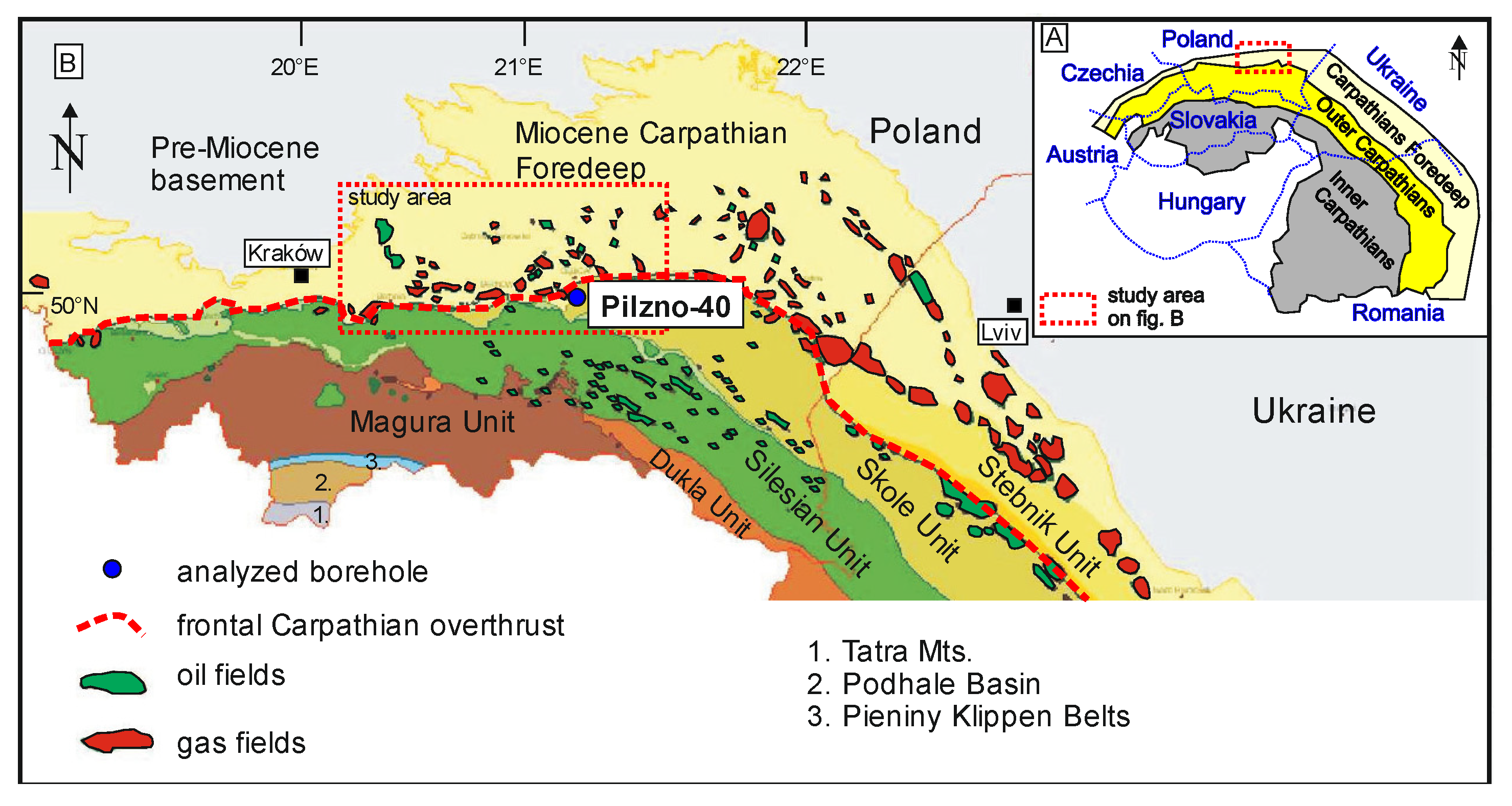
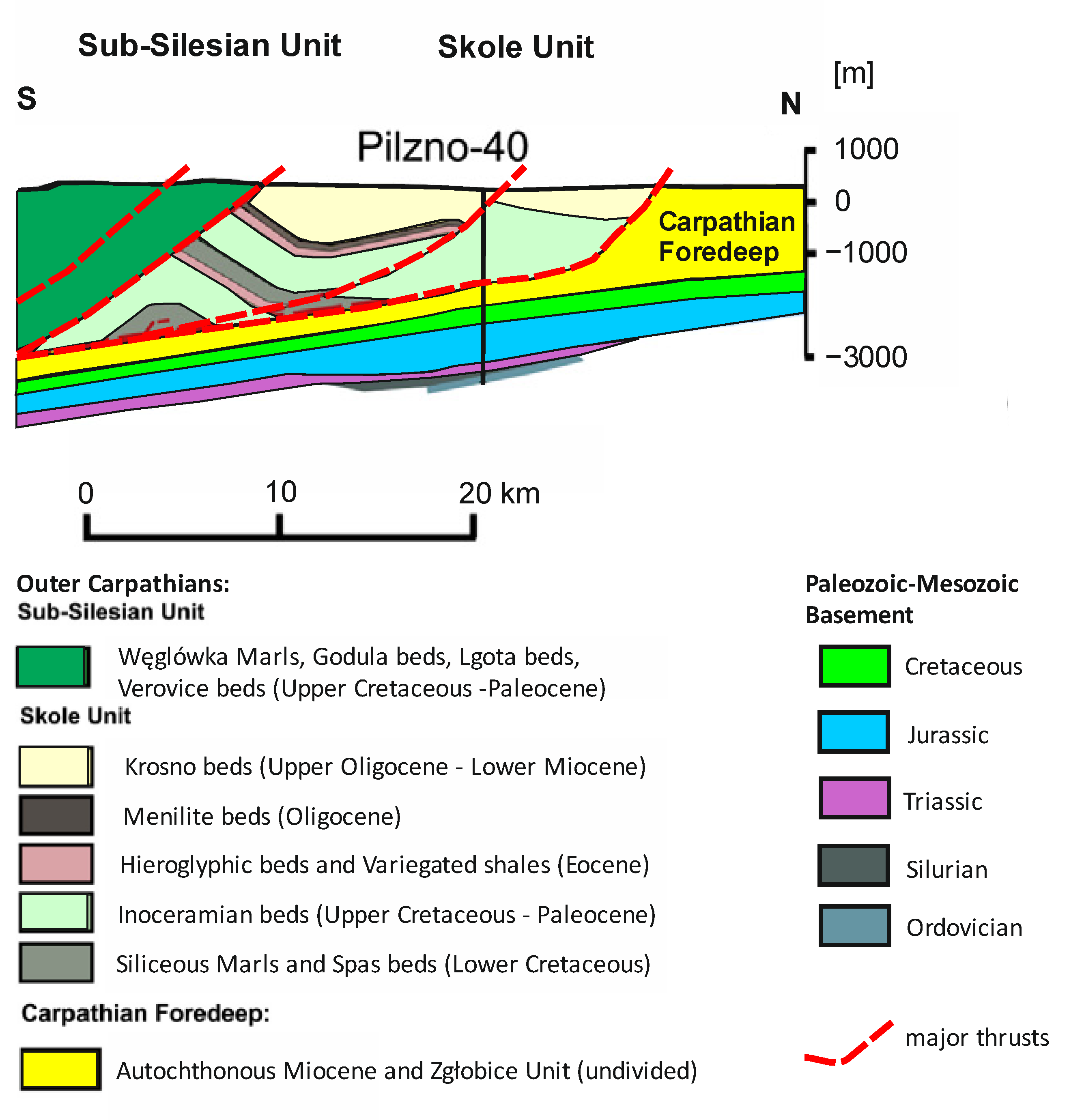
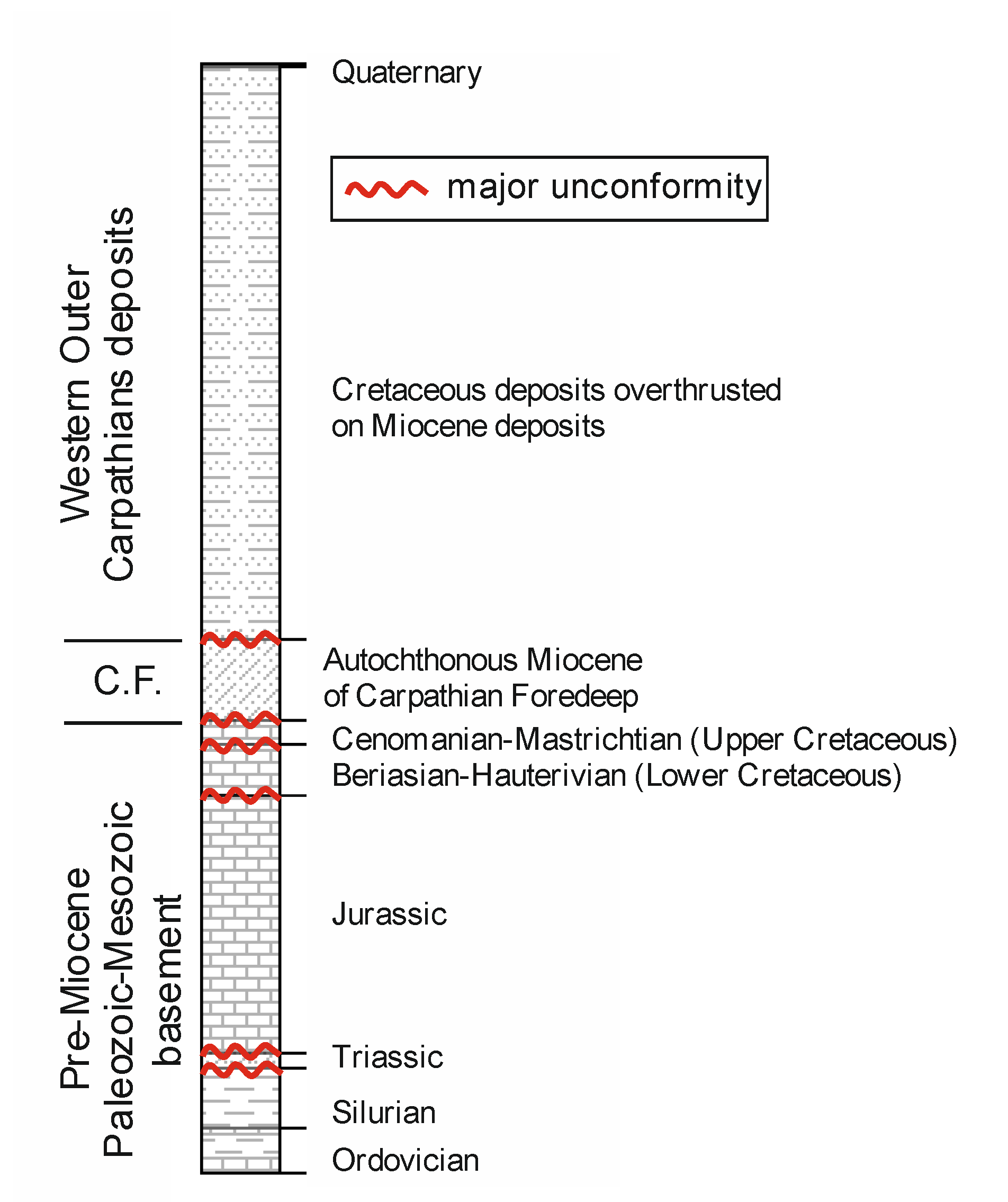



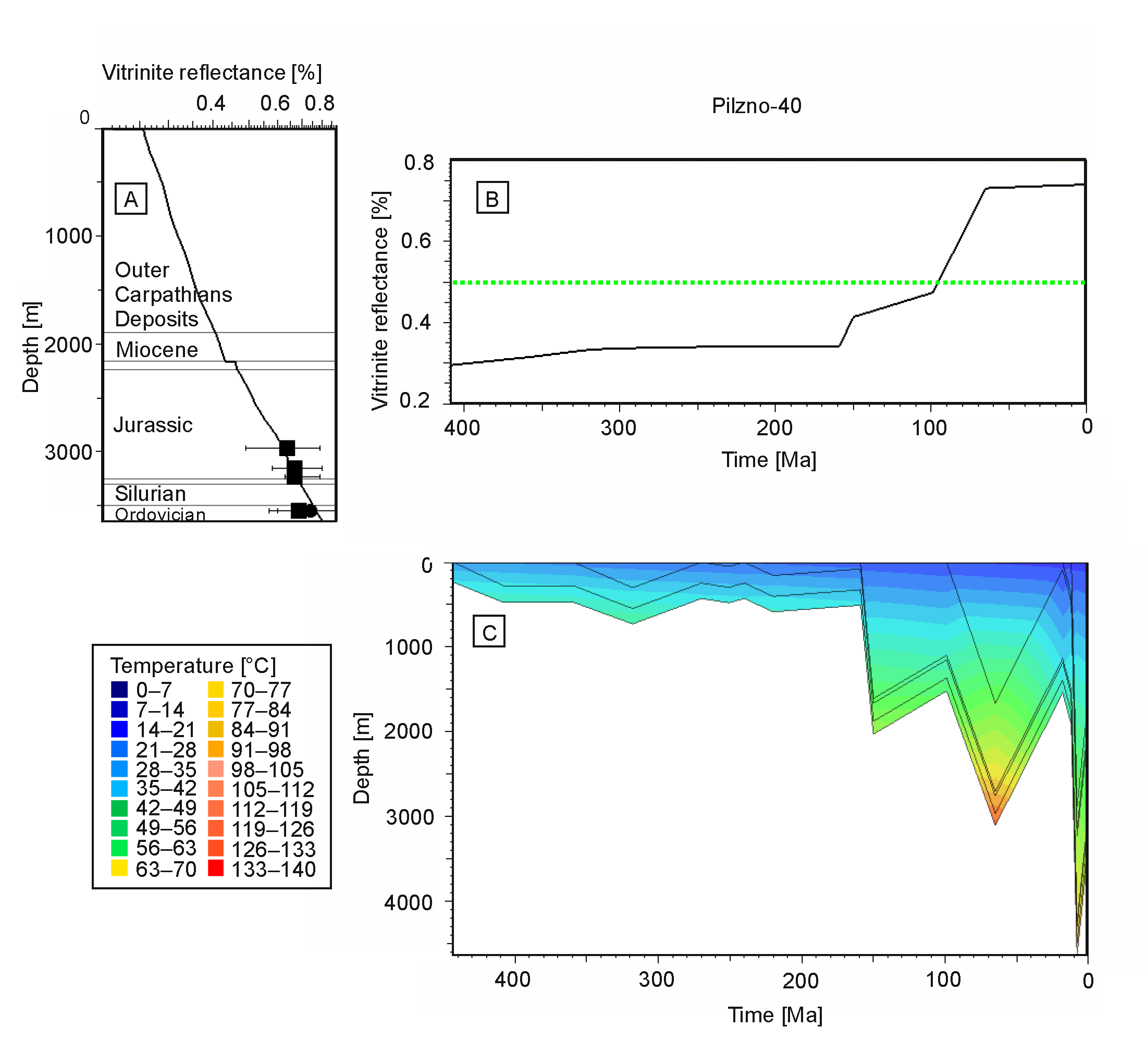

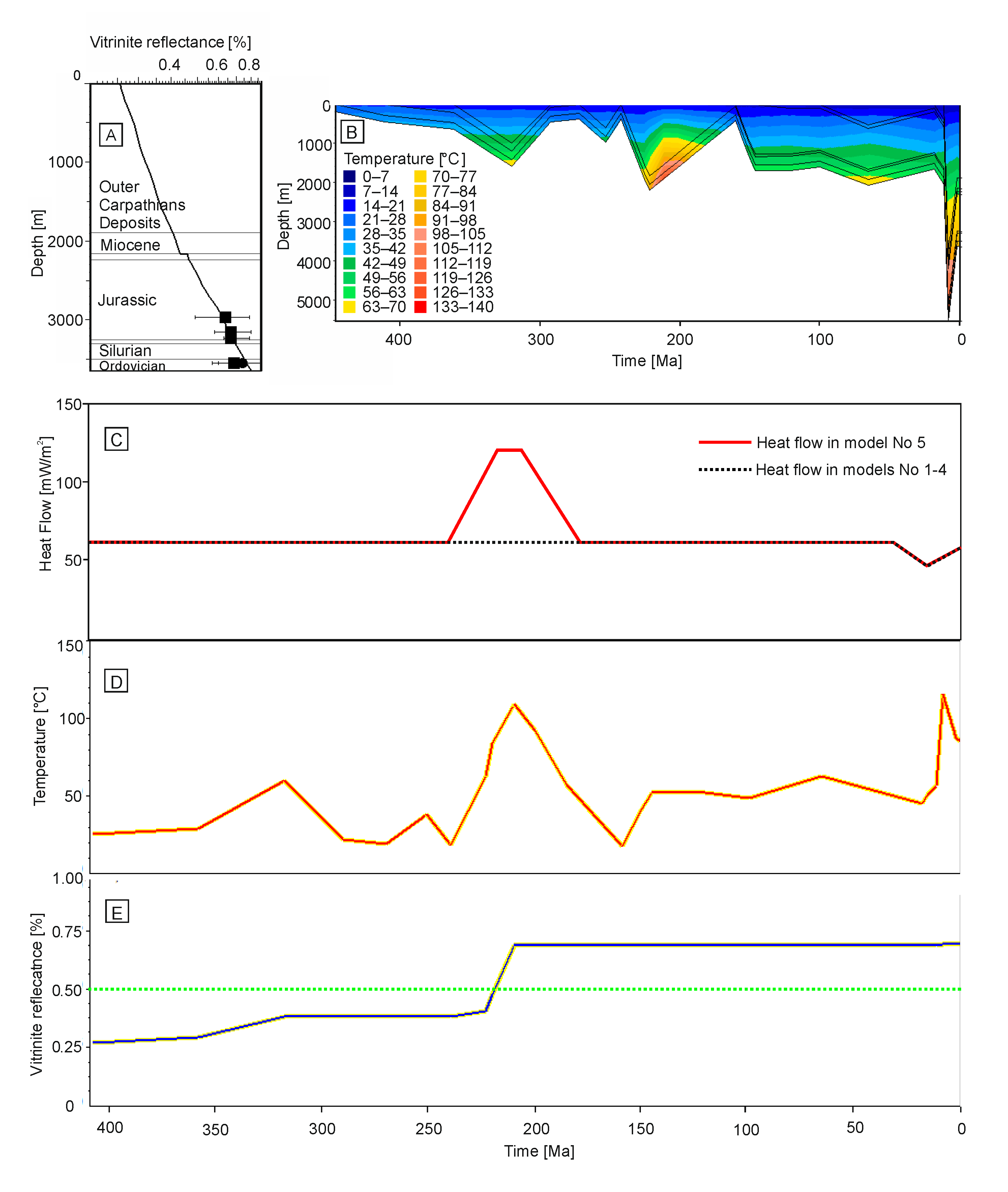
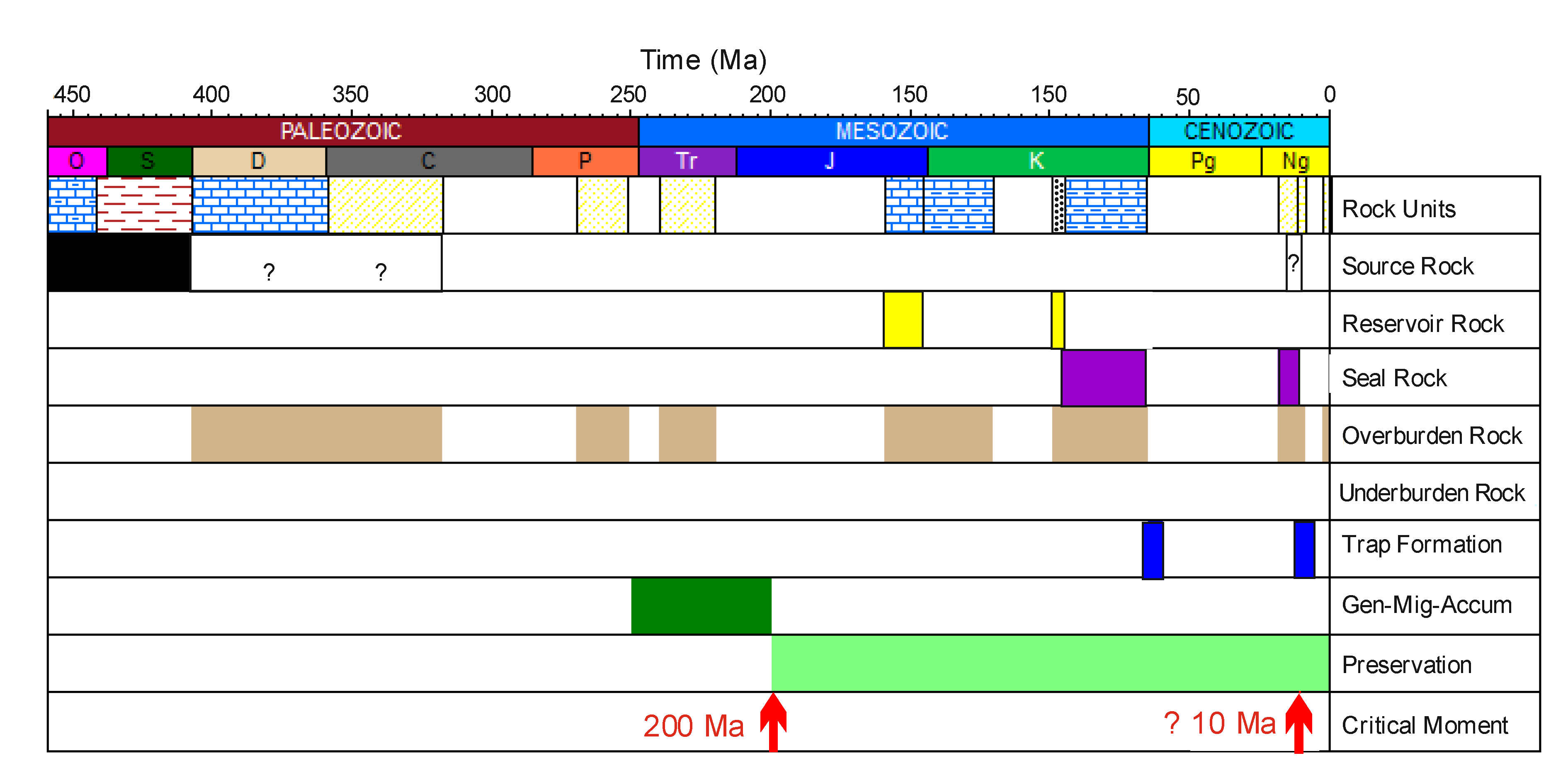
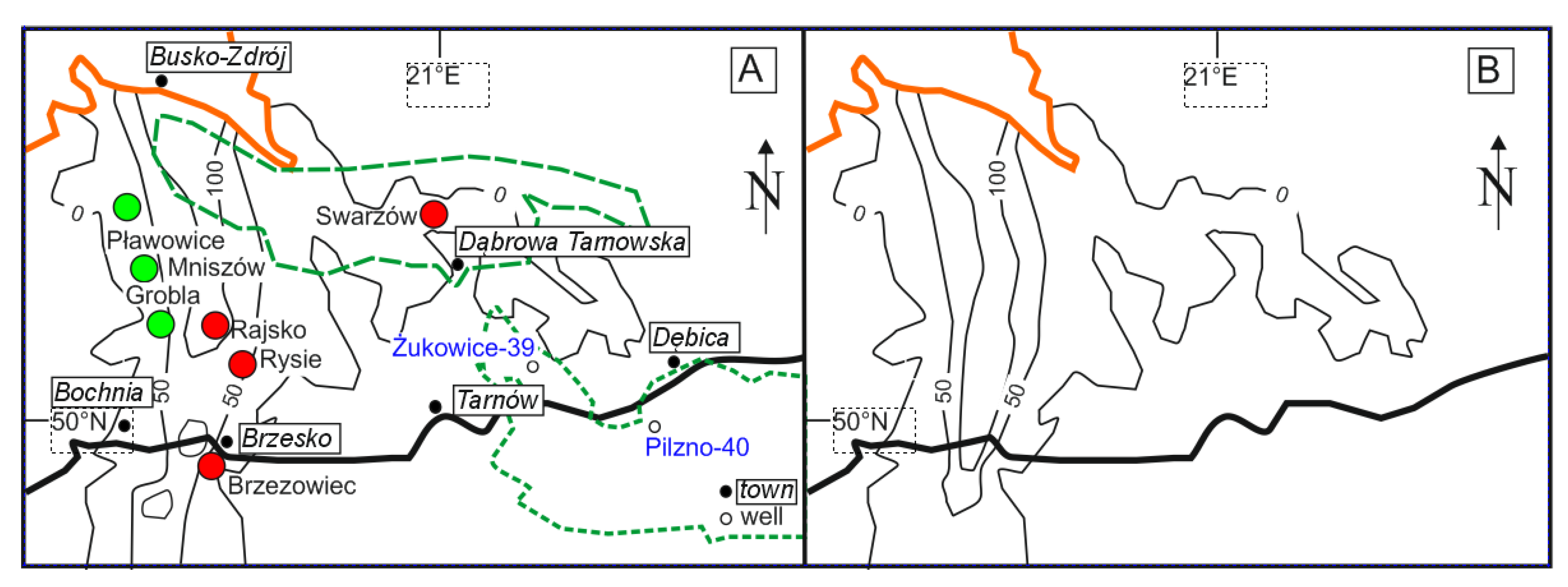
| Model Number | Pre-Miocene Major Burial Event | Age of Max. Burial (Ma) | Miocene Burial Stage * | Heat Flow (mW/m2) | Erosion (m) |
|---|---|---|---|---|---|
| 1 | No | 10 | Yes | 47 | 2000 |
| 2 | Devonian-Carboniferous (Variscan) | 320 | Yes | 62 | 1500 Devonian and 1200 Carboniferous |
| 3 | Jurassic-Cretaceous | 65 | Yes | 62 | 500 Jurassic, 800 Cretaceous |
| 4 | Cretaceous | 65 | Yes | 62 | 500 Jurassic, 2500 Cretaceous |
| 5 | Latest Triassic | 205 | Yes | 120 | 1500 |
Publisher’s Note: MDPI stays neutral with regard to jurisdictional claims in published maps and institutional affiliations. |
© 2021 by the author. Licensee MDPI, Basel, Switzerland. This article is an open access article distributed under the terms and conditions of the Creative Commons Attribution (CC BY) license (https://creativecommons.org/licenses/by/4.0/).
Share and Cite
Botor, D. Burial and Thermal History Modeling of the Paleozoic–Mesozoic Basement in the Northern Margin of the Western Outer Carpathians (Case Study from Pilzno-40 Well, Southern Poland). Minerals 2021, 11, 733. https://doi.org/10.3390/min11070733
Botor D. Burial and Thermal History Modeling of the Paleozoic–Mesozoic Basement in the Northern Margin of the Western Outer Carpathians (Case Study from Pilzno-40 Well, Southern Poland). Minerals. 2021; 11(7):733. https://doi.org/10.3390/min11070733
Chicago/Turabian StyleBotor, Dariusz. 2021. "Burial and Thermal History Modeling of the Paleozoic–Mesozoic Basement in the Northern Margin of the Western Outer Carpathians (Case Study from Pilzno-40 Well, Southern Poland)" Minerals 11, no. 7: 733. https://doi.org/10.3390/min11070733
APA StyleBotor, D. (2021). Burial and Thermal History Modeling of the Paleozoic–Mesozoic Basement in the Northern Margin of the Western Outer Carpathians (Case Study from Pilzno-40 Well, Southern Poland). Minerals, 11(7), 733. https://doi.org/10.3390/min11070733






